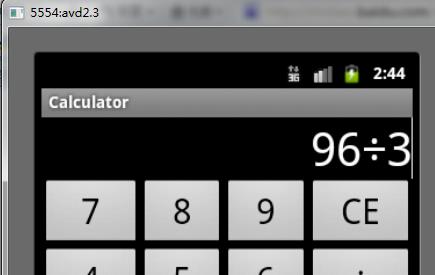Android中的EditText中,输入信息时,怎么能让光标停靠在输入的信息的右侧而不是左侧呢?
Posted
tags:
篇首语:本文由小常识网(cha138.com)小编为大家整理,主要介绍了Android中的EditText中,输入信息时,怎么能让光标停靠在输入的信息的右侧而不是左侧呢?相关的知识,希望对你有一定的参考价值。
本人刚刚自学android,不懂!求大家帮忙!谢谢!
类似图那样的!我做的计算器

先设置 android:gravity="right" 然后在.java程序中,在每次输出字符之后(text.setText(str);)重新设置光标位置:text.setSelection(str.length());

参考技术A 假设你的EditText文本框是edit;
edit.setSelection(edit.length());
这样就光标就会随着你输入而移动了。 参考技术B 不要用setText()方法,这个方法就会出现光标问题的 ,用发送消息的方法 参考技术C 可以在java代码中使用下面代码:
EditText show = findViewById(.............);
show.setSelection(show.getText().toString().trim().length()); 参考技术D 光标默认就是在右边啊。
ListView 中的 EditText 没有它回收输入
【中文标题】ListView 中的 EditText 没有它回收输入【英文标题】:EditText in ListView without it recycling input 【发布时间】:2012-03-15 08:54:15 【问题描述】:仍然是 android 的新手,甚至是自定义光标适配器的新手,所以我无法理解如何防止我的列表视图回收视图以防止滚动时来自一个编辑文本的输入显示在另一个中。我在其他帖子上看到说要更改 convertview 的名称,但如何做到这一点我是空白的。我希望这里有人能够根据我迄今为止编写的代码提供更多详细信息或示例。
public class editview extends ListActivity
private dbadapter mydbhelper;
private PopupWindow pw;
public static int editCount;
public static ListView listView;
/** Called when the activity is first created. */
@Override
public void onCreate(Bundle savedInstanceState)
super.onCreate(savedInstanceState);
mydbhelper = new dbadapter(this);
mydbhelper.open();
View footer = getLayoutInflater().inflate(R.layout.footer_layout, null);
ListView listView = getListView();
listView.addFooterView(footer);
showResults();
//Populate view
private void showResults ()
Cursor cursor = mydbhelper.getUserWord();
startManagingCursor(cursor);
String[] from = new String[] dbadapter.KEY_USERWORD;
int[] to = new int[] R.id.textType;
ItemAdapter adapter = new ItemAdapter(this, R.layout.edit_row, cursor,
from, to);
adapter.notifyDataSetChanged();
this.setListAdapter(adapter);
editCount = adapter.getCount();
//footer button
public void onClick(View footer)
final MediaPlayer editClickSound = MediaPlayer.create(this, R.raw.button50);
editClickSound.start();
startActivity(new Intent("wanted.pro.madlibs.OUTPUT"));
//custom cursor adapter
class ItemAdapter extends SimpleCursorAdapter
private LayoutInflater mInflater;
private Cursor cursor;
public ItemAdapter(Context context, int layout, Cursor cursor, String[] from,
int[] to)
super(context, layout, cursor, from, to);
this.cursor = cursor;
mInflater = LayoutInflater.from(context);
static class ViewHolder
protected TextView text;
protected EditText edittext;
@Override
public View getView(int position, View convertView, ViewGroup parent)
ViewHolder holder;
if (convertView == null)
convertView = mInflater.inflate(R.layout.edit_row, null);
holder = new ViewHolder();
holder.text = (TextView) convertView.findViewById(R.id.textType);
holder.edittext = (EditText) convertView.findViewById(R.id.editText);
convertView.setTag(holder);
else
holder = (ViewHolder) convertView.getTag();
cursor.moveToPosition(position);
int label_index = cursor.getColumnIndex("userword");
String label = cursor.getString(label_index);
holder.text.setText(label);
return convertView;
改成
class ItemAdapter extends SimpleCursorAdapter
private LayoutInflater mInflater;
private Cursor cursor;
Map<Integer, String> inputValues = new HashMap<Integer, String>();
public View getView(final int position, View convertView, ViewGroup parent)
....
ViewHolder holder;
if (convertView == null)
convertView = mInflater.inflate(R.layout.edit_row, null);
holder = new ViewHolder();
holder.text = (TextView) convertView.findViewById(R.id.textType);
holder.edittext = (EditText) convertView.findViewById(R.id.editText);
convertView.setTag(holder);
else
holder = (ViewHolder) convertView.getTag();
cursor.moveToPosition(position);
int label_index = cursor.getColumnIndex("userword");
String label = cursor.getString(label_index);
holder.text.setText(label);
String oldText = inputValues.get(position);
holder.edittext.setText(oldText == null ? "" : oldText);
holder.edittext.addTextChangedListener(new TextWatcher()
public void afterTextChanged(Editable editable)
inputValues.put(position, editable.toString());
但在所有edittext都有数据之后它正在回收。尝试使用 holder.edittext.setText(oldText) 但效果相同。
【问题讨论】:
【参考方案1】:解决方案是在设置文本之前删除添加的文本观察器。否则,该视图上的前一个 textwatcher 仍将与新的 textwatcher 一起被调用。将 textwatcher 作为标签存储在 EditText 上以跟踪它。
Object oldWatcher = viewHolder.quantitySold.getTag();
if(oldWatcher != null)
viewHolder.quantitySold.removeTextChangedListener((CustomTextWatcher)oldWatcher);
String oldText = inputValues.get("key"+position);
Log.d(TAG, "oldText: "+oldText+" position: "+position);
viewHolder.quantitySold.setText(oldText == null ? "" : oldText);
CustomTextWatcher watcher = new CustomTextWatcher(
cursor.getString(SKUFragment.COL_NAME),
cursor.getInt(SKUFragment.COL_ID),
cursor.getDouble(SKUFragment.COL_UNIT_PRICE),
position
)
@Override
public void beforeTextChanged(CharSequence s, int start, int count, int after)
@Override
public void onTextChanged(CharSequence s, int start, int before, int count)
@Override
public void afterTextChanged(Editable s)
if (s != null)
int quantity = 0;
if (!TextUtils.isEmpty(s.toString()))
quantity = Integer.parseInt(s.toString());
inputValues.put("key"+mPosition, "" + quantity);
else
inputValues.put("key"+mPosition, "");
double value = quantity * skuPrice;
mListener.onQuantityChanged(skuName+", position: "+mPosition, skuId, quantity, value);
;
viewHolder.quantitySold.setTag(watcher);
viewHolder.quantitySold.addTextChangedListener(watcher);
【讨论】:
【参考方案2】:首先,您确实不想阻止列表视图回收其视图。视图回收是一个巨大的优化。有关列表的许多非常好的信息,请参阅 google IO 谈话:http://www.youtube.com/watch?v=wDBM6wVEO70
话虽如此,您已经正确地确定了您的问题:您的 EditTexts 比您列表中的项目少得多。当您滚动浏览列表时,这些 EditTexts 会被回收,因此您会一遍又一遍地看到相同的输入。
基本上,您需要做的是将 EditTexts 的输入保存在某些数据结构中(如果他们只会编辑几个值,则为 HashMap,如果他们将更改大部分值,则可能是 List,两者都可以)映射输入的位置。您可以通过将 textChangedListener 添加到 getView 中的编辑文本来做到这一点:
@Override
public View getView(final int position, View convertView, ViewGroup parent)
...
cursor.moveToPosition(position);
int label_index = cursor.getColumnIndex("userword");
String label = cursor.getString(label_index);
holder.text.setText(label);
//clear whatever text was there from some other position
//and set it to whatever text the user edited for the current
//position if available
String oldText = yourMapOfPositionsToValues.get(position);
holder.setText(oldText == null ? "" : oldText);
//every time the user adds/removes a character from the edit text, save
//the current value of the edit text to retrieve later
holder.edittext.addTextChangedListener(new TextWatcher()
@Override
public void afterTextChanged(Editable editable)
yourMapOfPositionsToValues.put(position, editable.toString());
....
;
return convertView;
每当您的用户完成编辑后,您就可以遍历您的数据结构并对这些值执行任何操作。
编辑:
我将 onTextChanged 更改为 afterTextChanged,因为我以前使用过它并且我知道它有效。请记住,每次 LETTER 更改时都会调用 afterTextChanged,而不仅仅是在用户输入完一个单词之后。如果用户键入“dog” afterTextChanged 将被调用 3 次,首先是 'd',然后是 'do',然后是 'dog'。
HashMap 很简单:Map yourMapOfPositionsToValues = new HashMap();
添加或更新项目:yourMap.put(position, someText); 获取项目:yourMap.get(position);
如果哈希图没有意义,请花一些时间研究它们。它们是非常重要的数据结构。
您的 TextWatcher 实现不正确。您的数据结构不应属于单个视图,而应属于活动或适配器。在您看来,职位并不稳定,因为您的 List 归每个视图所有。位置本身是稳定的,除非基础数据发生变化,否则光标每次都会为相同的位置返回相同的数据。但是,编辑文本用于多个不同的位置。
创建一个哈希图作为我在上面在适配器的构造函数中演示的实例变量。然后正好加上我原来写的TextWatcher,不需要命名类,匿名更简单。您的代码应该可以工作。
【讨论】:
我在玩 aftertextchange 但我发现它并没有按照我想要的方式存储值。 IE 它只会将字符串的一部分存储到数组的不同部分中。我可以在最后一个 edittext 中输入类似 dog 的内容,以及何时调用 ArrayList以上是关于Android中的EditText中,输入信息时,怎么能让光标停靠在输入的信息的右侧而不是左侧呢?的主要内容,如果未能解决你的问题,请参考以下文章
在android中的EditText上输入时如何过滤ListView数据
Android Nougat 中的 ScrollView 在输入 EditText 时一直滚动到顶部,但在 Lollipop 中有效